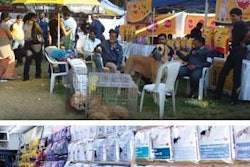This study compared the apparent total tract and ileal digestibility assays to measure AA absorption in commercial canine diets.
Five ileal cannulated dogs were fed five commercial dry canine foods selected to contain 19% to 30% CP in a 5 × 5 Latin square design. Ileal and total tract digestibility (apparent and standardized) of DM, OM, CP, crude fat (CF), carbohydrate and AA (including reactive Lys) were calculated using Cr2O3 as an indigestible marker. Greater apparent total tract digestibility values were found for DM, OM and CP compared with ileal digestibility values; however, CF had a greater ileal apparent digestibility.
Differences between sites in excess of 15 percentage units were recorded for AA. Apparent and standardized ileal reactive Lys digestibility was 3.1 to 15.3 percentage units greater than corresponding total tract digestibility values. For several indispensable AA, the bioavailability estimates currently used by the 2006 NRC and the 2011 Association of American Feed Control Officials to derive allowance estimates for canine adult maintenance were greater than the digestibility values of these AA in the commercial dog foods evaluated.
Although the canine large intestine is relatively short, the total tract digestibility assay in dogs can overestimate the digestibility of dietary AA and CP and may not be an accurate method for the measurement of absorption. In this study, bioavailability estimates of AA appeared to be less than those used to derive allowance estimates for commercial dog foods. Further work is required if current recommendations warrant adjustment.
Source: W.H. Hendriks et al., 2013. Comparison of ileal and total tract nutrient digestibility of dry dog foods. J Anim Sci online August 2013. doi: 10.2527/jas.2012-5864
















